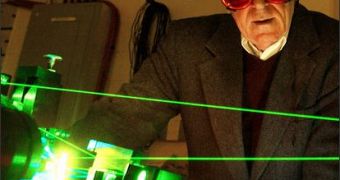John Cramer, a physicist at the University of Washington, wants to test one of his controversial predictions, that says light particles can go backward in time. The test involves using a crystal to split a photon into two reduced-energy photons that, through careful manipulation, Cramer thinks could reveal a flash of time traveling backward.
Some scientists, including world-famous theoretical physicist and author Stephen Hawking, say it won't work, supporting the "arrow of time" idea in which he argues that time can only advance in one direction: forward. It makes a lot of sense intuitively, since this is the only way we experience time.
Unfortunately, the one-way notion of time doesn't fit all that well with the mathematical and experimental evidence of quantum theory. This is a highly counter-intuitive branch of physics, also known as quantum mechanics, that describes the bizarre behavior of matter at the atomic and subatomic levels.
One of the mysteries of quantum mechanics is the Einstein-Podolsky-Rosen paradox: if one takes quantum mechanics and adds some seemingly reasonable conditions (referred to as locality, realism, counter factual definiteness, and completeness), then one obtains a contradiction. However, quantum mechanics by itself does not appear to be internally inconsistent, nor does it contradict relativity.
Quantum theory predicts two subatomic particles derived from a single particle - like two photons split from a single photon - will, if not further influenced by other particles, continue to influence each other's behavior no matter how far apart. What Cramer hopes to be able to do is split a photon, sending two "entangled" photons down two very different pathways of varying lengths using fiber-optic cables. Photons can exist in either particle or wave forms. The outcome can be manipulated by placement of detectors.
Because the photons are entangled, however one is detected (whether as a particle or a wave) also will determine the form taken by the other. But by running one photon through a 10-kilometer spool of optic cable, the second photon will be delayed for 50 microseconds.
In short, moving the location of the detector for the delayed photon to change it from wave to particle would also change the first photon - according to standard quantum theory. For this to happen, some kind of signal has to go backward in time.
Stephen Hawking and others argue that, even if observations on entangled states naively appear to conflict with the property of relativity that information cannot be transferred faster than the speed of light. Although two entangled systems appear to interact across large spatial separations, no useful information can be transmitted in this way, so causality cannot be violated through entanglement. This is the statement of no communication theorem.
"There's been a lot of interest in this problem over the years," Cramer said. In 1986, he proposed a solution to this paradox that he called the "transactional interpretation of quantum mechanics":
Suppose a particle (such as a photon) emitted from a source could interact with one of two detectors. According to TIQM, the source emits a usual (retarded) wave forward in time, the "offer wave", and when this wave reaches the detectors, each one replies with an advanced wave, the "confirmation wave", that travels backwards in time, back to the source. The phases of offer and confirmation waves are correlated in such a way that these waves interfere positively to form a wave of the full amplitude in the space-time region between emitting and detection events, and they interfere negatively and cancel out elsewhere in space-time (before the emitting point and after the absorption point).
The size of the interaction between the offer wave and a detector's confirmation wave determines the probability with which the particle will strike that detector rather than the other one. In this interpretation, the collapse of the wavefunction does not happen at any specific point in time, but is "atemporal" and occurs along the whole transaction, the region of space-time where offer and confirmation waves interact.
The waves are seen as physically real, rather than a mere mathematical device to record the observer's knowledge as in some other interpretations of quantum mechanics. "In 20 years, nobody has been able to tell me why this can't work," Cramer said. "They just say it can't work like that."

 14 DAY TRIAL //
14 DAY TRIAL //